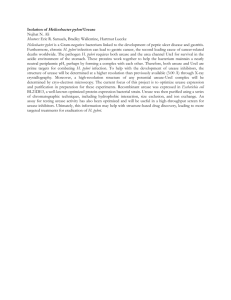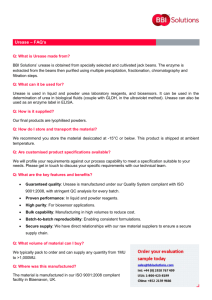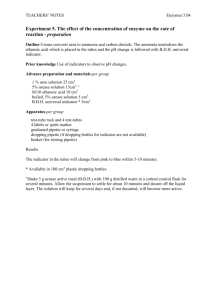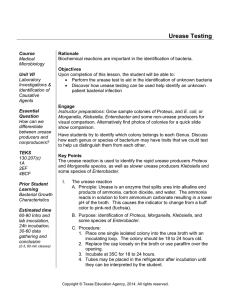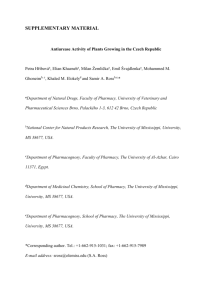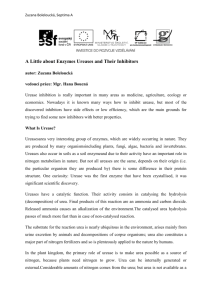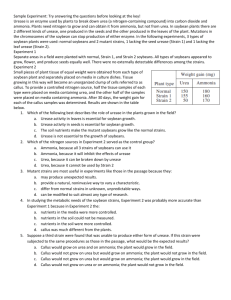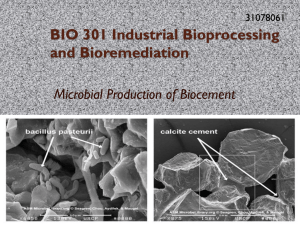Prezentacja programu PowerPoint
advertisement
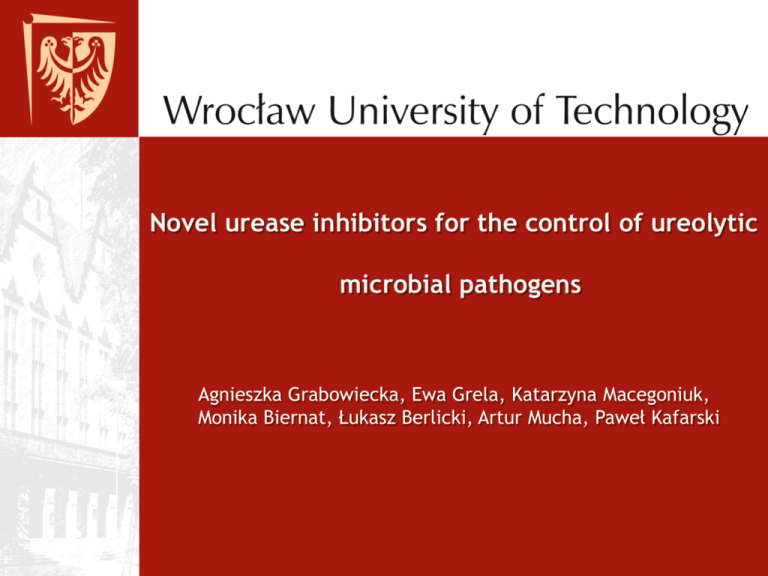
Novel urease inhibitors for the control of ureolytic microbial pathogens Agnieszka Grabowiecka, Ewa Grela, Katarzyna Macegoniuk, Monika Biernat, Łukasz Berlicki, Artur Mucha, Paweł Kafarski Urease - urea amidohydrolase 3.5.1.5 Bacillus pasteurii, PDBid 1S3T Benini, S., et al. Structure. 1999. 7 (2): p.205-216 Urease - reaction 2NH3 + 2H2O 2NH4+ + 2OH- (kcat/Km)/kuncat 8 ·1017 M-1 Regulation of microbial urease Mechanism Microorganism Urea induced Proteus mirabilis, Proteus vulgaris, Proteus penneri, Providencia rettgeri , Providencia stuartii Constitutive Sporosarcina pasteurii, Morganella morganii , Corynebacterium renale, Agrobacterium tumefaciens, Neurospora crassa, Rhizobium leguminosarum pH Repressive Streptococcus salivarius Klebsiella aerogenes, Pseudomonas fluorescens, Pseudomonas aeruginosa, Alcaligenes eutrophus, Bacillus megaterium , Micrococcus cerificans Inhibitors for the control of urease Amides and esters of phosphoric and thiophosphoric acids Hydroxamic acids AHA Ki H.pylori 2µM NH(Lys) O O (His)N Ni (His)N IC50 H.pylori Urea derivatives Heavy metal ions Ni OH O 1.2 nM N(His) N(His) O(Asp) NH Quinones Polyphenols Heterocycles Benini, S.; Rypniewski, W.R.; Wilson, K.S.; Miletti, S.; Ciurli, S.; Mangani, S. The complex of Bacillus pasteurii urease with acetohydroxamate anion from X-ray data at 1.55 A resolution. J. Biol. Inorg. Chem. 2000, 5, 110 - 118 Aminophosphinic analogs of phosphoramidates Stamatia Vassiliou, Agnieszka Grabowiecka, Paulina Kosikowska,Athanasios Yiotakis,Paweł Kafarski, and Łukasz Berlicki. Design, Synthesis, and Evaluation of Novel Organophosphorus Inhibitors of Bacterial Ureases. J. Med. Chem. 2008, 51, 5736–5744 Modification of P- and N- termini H2N O OH P OH 𝑲𝒊 = 314 µM (SPU) O H3N O NH2 H2N O OH P N O OH P OH 𝑲𝒊 = 13 µM (SPU) H2N O OH P OH 𝑲𝒊 = 95 µM (SPU) 𝑲𝒊 = 340 µM (SPU) Stamatia Vassiliou,Paulina Kosikowska,Agnieszka Grabowiecka, Athanasios Yiotakis, Pawe ł Kafarski, and Łukasz Berlicki. Computer-Aided Optimization of Phosphinic Inhibitors of Bacterial Ureases. J. Med. Chem. 2010, 53, 5597–5606 Łukasz Berlicki, Marta Bochno, Agnieszka Grabowiecka, Arkadiusz Białas, Paulina Kosikowska, Paweł Kafarski. N-substituted aminomethanephosphonic and aminomethane-Pmethylphosphinic acids as inhibitors of ureases. Amino Acids (2012) 42:1937–1945 N O OH P 𝑲𝒊 = 0.62 µM (SPU) H N O OH P OH 𝑲𝒊 = 0.43 µM (SPU) Katarzyna Macegoniuk, Anna Dziełak, Artur Mucha, and Łukasz Berlicki. Bis(aminomethyl)phosphinic Acid, a Highly Promising Scaffold for the Development of Bacterial Urease Inhibitors. ACS Med. Chem. Lett. 2015, 6, 146−150 Compound nr 11 1 12 2 13 3 14 4 15 5 16 6 17 7 18 8 19 9 20 10 21 Proteus mirabilis Adhesins and 17 fimbrial types – adhesion to uroepithelium and catheters Swarming motility in rafts – polymicrobial ascending UTI Agressive iron acquisition – unique proteobactin and enterobactins siderophores Hemolysin and agglutinin toxins Serralysin production Biofilm formation Horizontal gene transfer for pathogenicity and resistance Nitrogen metabolism – urease and glutamate dehydrogenase Chelsie E. Armbruster and Harry L.T. Mobley. Merging mythology and morphology: the multiphaceted lifestyle of Proteus Mirabilis. Nat. Rev. Microbiol. 2012 10(11): 743-754 Crystallization in infected urine Unique surface and internal structure of struvite crystals formed by Proteus mirabilis Prywer J, Torzewska A, Płociński T - Urol. Res. (2012) Przegląd Urologiczny 2010/2 (60) Proteus mirabilis PCM 543 – urease activity Indophenol blue assay Colorimetric ammonium quantification Proteus mirabilis PCM 543 – viability estimation „MTT” chromogenic assay of dehydrogenase activity Fluorescent staining LIVE/DEAD BacLight L-7012 Influence of the studied urease inhibitors upon the whole-cell ureolytic activity and viability of Proteus mirabilis PCM543 Ki [µM] Percent Viability MTT ΔNH4+ [mM] ΔPO4-3 [mM] pH Compound Percent preserved ureolytic activity Untreated culture 100 100 12 -6.5 9.6 70±2.2 26±4 30±6 4.0 -3.4 7.4 13±0.8 8±2 36±4 2.2 -0,6 5.6 27±0.3 34±6 61±8 5.3 -0.29 7.5 0.62±0.09 2±0.3 25±3 2.8 -1.4 6.0 0.36±0.10 35±5 74±5 4.7 -3.7 7.4 3.10±0.65 24±6 59±7 4.3 -1.8 7.2 5.2±0.42 6±3 53±4 3.1 -1.6 6.1 Ki [µM] Percent Viability MTT ΔNH4+ [mM] ΔPO4-3 [mM] pH 82 ±12 Percent preserved ureolytic Activity 37±9 58±12 7.8 -4.6 8.2 34 ± 8 10±2 63±6 3.3 -1.0 6.3 24.4 ± 4.1 4±0.5 96±5 2.9 -1.3 6.15 16.0 ± 1.1 17±5 57±9 3.6 -1.7 6.7 416 ± 50 75±7 98±3 10.0 -5.8 9.2 25.9 ± 3.0 32±8 65±5 11.5 -4.2 7.9 0.202±0.057 4±0.7 40±7 2.5 -0.7 5.7 778 ± 127 30±4 56±4 9.8 -5.1 8.6 NI 68±11 60±6 9.0 -6.2 8.9 Compound Ki [µM] Percent preserved ureolytic Activity Percent Viability MTT ΔNH4+ [mM] ΔPO4-3 [mM] pH NI 96±5 97±8 13.0 -6.3 9.5 58.3 ± 8.0 92±6 90±7 7.0 -6.9 7.6 NI 100 99±4 12.0 -6.6 8.5 17.2± 2.5 26±7 76±7 4.5 -2.1 7.3 24.52± 4.54 89±6 96±6 7.0 -6.7 8.4 5.7±4 42±6 56±7 9.2 -4.0 7.8 Compound AHA Urine precipitate Untreated culture AHA 31P – NMR analysis of urine sediment AHA 1mM 1mM Urine stability Kinetics of whole-cell urease Untreated culture Helicobacter pylori J33 High virulence: CagA protein VacA cytotoxin swarming urease Intra- and extracellular form Ha CN, Oh ST, Sung JY, Cha KA, Hyung LM, Oh BH 2001.Supramolecular assembly and acid resistance of Helicobacter pylori urease. Nat Struct Biol 8(6): 505-509 Protection from acid Ni scavenging Up to 10% cell protein, constitutive, Km~0.3mM H. pylori J33 urease inhibition screening Structure Helicobacter pylori (purified enzyme) E. coli + pGEM::ureOP IC50 (µM) IC50 2 h INC (µM) Helicobacter pylori (whole cells) IC50 (µM) Ki (µM) 720,71 60,98 ± 70,11 ± 9,21 274,67 20,86 879.58 439.71 1500 550 ± 20,03 ± 2,03 ± 104.83 ± 60.99 ± 160 ± 70 248,09 22,08 746.45 305.62 <4200* ± 20,03 ± 2,11 ±93.68 ± 43.17 212,79 27,02 779.35 284.09 1470 570 ± 15,67 ± 2,070 ± 99.26 ± 41.42 ± 210 ± 120 5,63 0,29 186.36 16.92 1500 410 ± 0,317 ± 0,01 ±29.59 ±2.23 ± 200 ± 200 1506,7 877,6 3357.17 2256.42 1460 640 ± 114,15 ± 24,7 ± 568.21 ± 350.99 ± 400 ± 30 219,23 26,14 269.48 470 210 ± 18,67 ± 1,78 ± 38.51 ± 80 ± 80 NA IC 50 (µM) IC50 2 h INC (µM) <18700* 210 ± 20 1257.64 ± 187.86 480 ± 200 Structure Helicobacter pylori (purified enzyme) E. coli + pGEM::ureOP IC50 (µM) Ki (µM) IC50 (µM) 34.25 ± 2.95 9.27 ± 0.35 179.35 ± 32.29 3.56 ± 0.321 179.43 ± 12.94 1.03 ± 0.068 38.29 ± 1.08 381.03 ± 31.46 74.26 ± 4.65 - 344.23 ± 17.61 61.64 ± 3.52 573.29 ±76.02 IC50 2 h INC (µM) Helicobacter pylori (whole cells) IC 50 (µM) IC50 2 h INC (µM) <9570* 600 ± 170 520 ± 170 690 ± 150 580 ± 80 170 ± 30 - 250 ±2 250 ± 100 306.22 ±48.38 350 ± 130 510 ± 130 25.06 ±4.86 759.37 ±106.43 429.72 ± 62.74 163.85 110.28 ±24.12 ±21.13 Time of incubation 2.5 IC50 [mM] 2 5 min 1.5 10 min 20 min 1 30 min 150 min 0.5 0 5 5 6 6 7 7 14 14 15 18 15 18 7.00 6.00 Nr 5.00 IC50 [mM] 5 4.00 6 3.00 7 2.00 1.00 0.00 8 No preincubation 5 0.43 6 0.58 7 0.32 8 5.35 2h preincubation 0.17 0.54 0.53 0.69 Inhibitor 8.00 Nr 7.00 9 6.00 10 IC50 [mM] 5.00 11 4.00 12 3.00 13 2.00 14 1.00 15 0.00 9 No preincubation 1.50 2h preincubation 0.55 10 2.44 11 1.47 12 3.98 13 6.01 14 1.54 15 1.47 16 1.46 0.46 0.61 0.93 5.37 0.66 0.64 0.39 16 Inhibitor Summary Aminophosphinates are efficient inhibitors of bacterial urease They prevent struvite crystallization in artificial urine infection model H. pylori cells are more resistant to urease inhibition Studied structures are analogs of aminoacids and urease transition state Aminophosphinates are hydrolytically stable and resistant to microbial degradation Aminophosphonates possess chelating properties Amphiphilic structures affect OM integrity THANK YOU !
